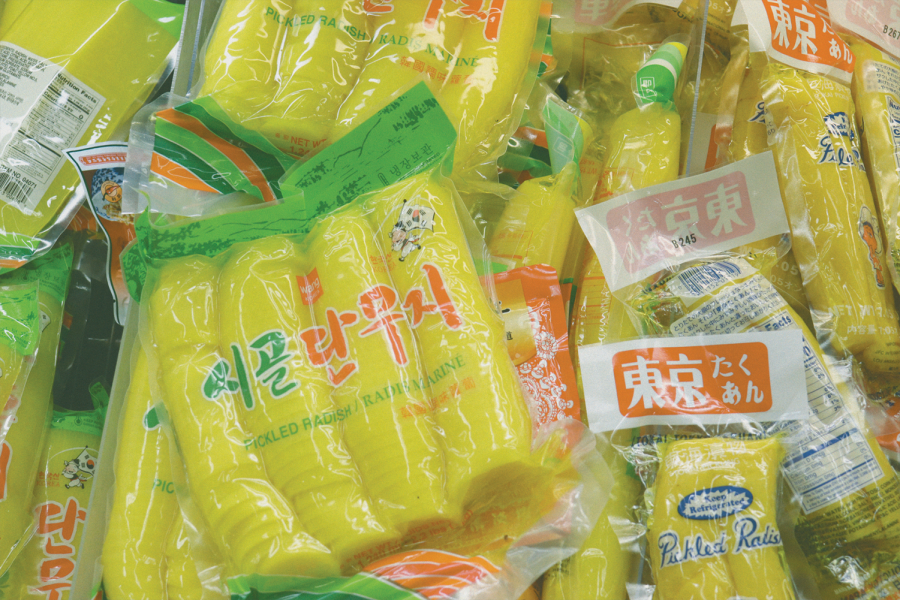Corners of Culture
PALY students explore their personal cultures through their local cultural markets
Sitting at the dinner table at her cousin’s house in the Philippines, sophomore Naomi Tan was surprised by how many traditional Filipino dishes she could name. The spring rolls to the right of her were “Lumpia,” and the chicken and rice porridge on the other side of her was “Arroz Caldo.” These were all dishes that her mother had made for her back in Palo Alto.
“When I went to the Philippines, they had a bunch of dishes on the table and I was still able to identify them, just because my parents cooked them at home,” Tan said. “Even though I live in the U.S., I’m still able to get a taste of their culture.”
Tan attributes Asian grocery stores in the Bay Area, particularly 99 Ranch in Mountain View, for allowing her parents to cook their cultural food and familiarize her with dishes from China and the Philippines.
“My parents are from the Philippines, but I’m ethnically Chinese, so my parents will cook a mix of both foods and fuse them together in a way,” Tan said. “They get a lot of those ingredients to cook these meals from Ranch 99.”
While Tan does not usually shop at 99 Ranch herself, she appreciates that the store sells the ingredients her mom needs to cook Chinese and Filipino food for her family.
“If my mom wants to make a dish specific to where she’s from, she’ll go to [99 Ranch], and then through that, I’m able to get a taste of the culture,” Tan said. “Cultural grocery stores definitely do play a big part in my family’s [cultural identity].”
99 Ranch is one of many grocery stores in the Bay Area that specializes in ingredients and prepared food from a specific culture. Another renowned grocery store is the Middle Eastern market called Rose Market.

Senior Anushe Irani shops at Rose Market, a middle eastern grocery store in Mountain view, for Persian food and ingredients, and sees it as a crucial part of her ability to connect with her cultural identity as a Persian American.
“I feel like [Persian grocery stores] definitely keep the culture alive,” Irani said. “I learn a lot about my culture through food.”
Junior Natalia Trounce and her family regularly shop at a Russian grocery store called Samovar in Mountain view.
“Cultural stores are special because they have foods that are from my childhood. My grandma would go there and always bring me back Russian candy,” Trounce said.
The existence of numerous cultural grocery stores in close proximity to each other is a unique element of Bay Area’s culture, one that may be a reflection of the strong immigrant presence in the area.
While grocery stores are one specific way in which Paly students are able to connect with their cultures, this suggests a larger theme of food having the ability to sustain a person’s cultural preservation. Trounce feels that food is not only important to the preservation of culture, but is one of the most integral aspects of keeping a culture alive.
“I think if I had not been able to taste Russian food, I would not feel Russian,” Trounce said. “I would be just completely disconnected from it, because being able to eat the food gives me a sense of actually being Russian.”
Irani feels this connection most strongly when she is able to cook Persian food.
“There’s some history behind [cultural food] and learning about how to cook it yourself can sometimes help you connect better with [that history] and your culture,” Irani said.

Beyond a personal connection to one’s culture when cooking their cultural food, freshman Nephila Subaanin, who regularly goes to Madras, an Indian grocery store in Sunnyvale, feels that cultural meals also provide for deeper family and community bonding.
“Everyone has different dishes that they make…, [and] even the way it’s eaten can connect families and communities together,” Subaanin said.
Trounce agrees that sharing her family’s cultural food with other families allows for cultural gaps to be bridged.
“It’s a way to share your culture with other people, having them over for a Russian meal is nice because it gives them a taste of your culture,” Trounce said.
While many Paly students feel that cooking and eating their cultural food is important, some remember a time when they felt some shame surrounding the “unique” food that they would bring to school.
“In elementary school, I felt weird about eating Persian food because it looked different, and I guess kids were more judgemental back then,” Irani said. “Now, I’ve met different people and people who had different lunches and it made me more comfortable with what I was eating.”
Subaanin acknowledges that many people may feel this sense of shame, but she believes this shouldn’t be the case.
“[People] have no reason to feel ashamed about [eating cultural food],” Subaanin said. “It’s part of the identity, so they should be proud of it.”
In addition to helping people to feel more pride about their cultural meals, cultural grocery stores have the ability to introduce people to new types of food and lessen the judgment that leads to this sense of shame in the first place.
“I think [going to cultural grocery stores] might open people’s current horizons because they might have preconceived notions about what a certain culture’s food is supposed to be,” Trounce said. “I think it would help people to see the variety and richness that exists within each culture and just the amazing combinations that all these different cultures have created independently.”
Subaanin agrees that more people going to cultural grocery stores could help change the stigma around “non-western” or “non-American” foods.
“I think that [people] should try going [to these grocery stores] because then they can experience other cultures and see what they eat, and become educated and aware and maybe even more accepting,” Subaanin said.
For a person who has never experienced a grocery store catered to a specific culture, these stores can allow for a completely new way of experiencing and enjoying food and grocery shopping.
“The minute you walk in, it’s just a very different aura,” Tan said. “You hear people speaking in different languages and the food on the shelves could be things you’ve never seen before, so it’s just a really fun experience to get a glimpse into a different culture.”



Photos by Anna Markesky and Ella Rosenblum
Print Issue
Please click on the three vertical dots on the top right-hand corner, then select “Two page view.”

2020-2021 - Staff Writer
2021-2022 - Social Media Manager
2022-2023 - Multimedia Director
I joined C Mag because I wanted to explore how art can...

2021 - 2022 - Staff Writer
2022-2023 - Social Media Manager
I joined C-mag to be part of a writer's community. C-Mag has such an impressive combination...

2020-2021 - Staff Writer
2021-2022 - Business Manager
Hello! My name is Natalie Hmelar, I am the C Mag business manager. I love being in C Mag because...







